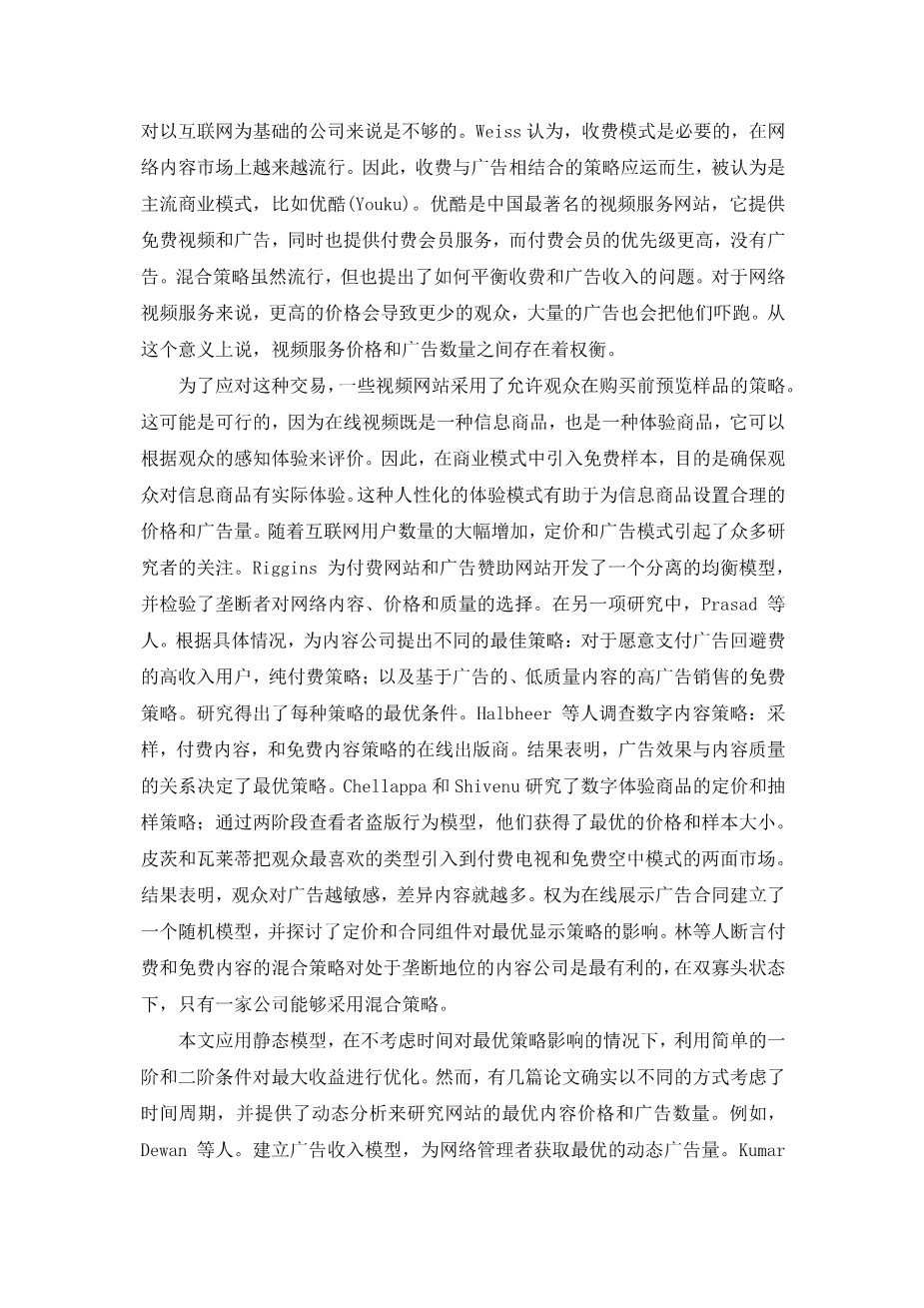Two-Stage Dynamic Pricing and Advertising Strategies for Online Video Services
As the demands for online video services increase intensively, the selection of business models has drawn thegreat attention of online providers. Among them, pay-per-view mode and advertising mode are two importantresource modes, where the reasonable fee charge aund suitable volume of ads need to be determined. This paperestablishes an analytical framework studying the optimal dynamic pricing and advertising strategies for onlineproviders; it shows how the strategies are influenced by the videos available time and the viewers emotionalfactor. We create the two-stage strategy of revenue models involving a single fee mode and a mixed fee- freemode aund find out the optimal fee charge and advertising level of online video services. According to the results,the optimal video price and ads volume dynamically vary over time. The viewers aversion level to advertisinghas direct effects on both the volume of ads and the number of viewers who have selected low. quality content.The optimal volume of ads decreases with the increase of ads-aversion coeffcient, while increasing as the qualityof videos increases. The results also indicate that, in the long run, a pure fee mode or free mode is the optimalstrategy for online providers.
Apart from text and images, video is the most important form of online media, which has been widely regarded as the future of media on the Internet. According to Cisco Visual Networking Index 2015–2020 prediction, by 2020, 82% of viewer Internet traffic will be video and total global Internet traffic will increase at 22% per year. High-quality online video service brings not only profits but also reputation and user reliability to the companies. The latter is rather more important for companyrsquo;s long term life cycle. For example, Youtube has attracted over a billion users all over world, because it offers free video services, selected advertising options, and a much faster streaming ability thanks to its great technologies such as Content Delivery Network (CDN) and Google File System (GFS). In other words, Youtube has paid a lot of attention to user experience and thus gains a large and stable user group, which makes Youtube one of the most famous video websites in the world. However, in 2014 Youtube annual revenue was posted at about $4 billion, which accounted for about 6% of Googlersquo;s overall sales, which increased to $9 billion in 2015. This indicates that there will be a large potentiality for Youtube to be more profitable. Not only does Youtube exist, but also there are various Internet video sites such as Vimeo (US), Hulu (US), Youku (China), Dailymotion (France), Niconico (Japan), and Pandora TV (South Korea), competing in the online video market all over the world.
As the online video service has a glorious future, it is attractive and important to investigate its business models. There are several profiting modes, which mainly include three patterns: sales or redistribution of copyrights for certain films, charges for video services, and advertising revenue. In this paper, we will discuss the two latter cases dealing with online video users. Many video websites adopt the strategy of providing free video services to maximize membership. The revenues of this mode mainly depend on advertising. However, recent studies report that, with only advertising revenue, it is not sufficient for Internet-based companies [1, 2]. According to Weiss [3], fee charge mode is necessary and becoming more popular in web content market. Hence, the strategy of combining fee charge and advertising has emerged, which has been regarded as the mainstream business model, such as Youku, the most famous video service website in China, which offers free videos with ads as well as a paid membership with a higher priority and no ads. Although the mixed strategy is popular, it also raises the problem of how to balance the revenue from fee charging and advertising. For Internet video services, higher prices result in fewer viewers, and a large amount of ads will also scare them away. In this sense, there exists a trade-off between video service price and the amount of ads.
In order to deal with this trade-off, some video websites adopt strategy that allows viewers to preview samples before buying. It might be feasible, because online video is a sort of information goods as well as experience goods, which could be valued according to viewersrsquo; perceived experience [4]. Hence, free samples are introduced into the business models with the purpose of ensuring that viewers have an actual experience with information goods [5, 6]. This humanized experience mode is helpful to set up reasonable price and ads volume for information goods. With significant increasing number of the Internet users, the pricing and advertising models have attracted attention of many researchers. Riggins [7] develops a separating equilibrium model for fee-based and ads sponsored-based websites and examines a monopolistrsquo;s choice of web content price and quality. In another study, Prasad et al. [8] suggest different optimal strategies for content firms depending on the context: pure pay-per-view strategy for high income users, who are willing to pay the advertising avoidance fee, and free strategy based on advertisement for high advertising sales with low-quality content. The study derives the optimal condition for each strategy. Halbheer et al. [9] investigates digital content strategies: the sampling, paid content, and free content strategies for online publishers. Results show that the optimal strategy is determined by the relationship between advertising effectiveness and content quality. Chellappa and Shivendu [1] examine pricing and sampling strategies for digital experience goods; through a two-stage viewer piracy behavior model they obtain the optimal price and sample size. Peitz and Valletti [10] introduce the factor of
剩余内容已隐藏,支付完成后下载完整资料


英语译文共 3 页,剩余内容已隐藏,支付完成后下载完整资料
资料编号:[609722],资料为PDF文档或Word文档,PDF文档可免费转换为Word
以上是毕业论文外文翻译,课题毕业论文、任务书、文献综述、开题报告、程序设计、图纸设计等资料可联系客服协助查找。


